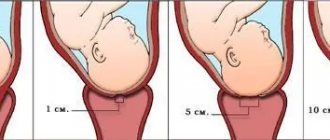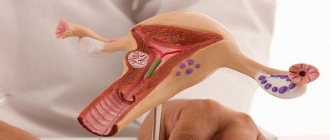Cervical plastic surgery (tracheloplasty) is an operation performed to restore its shape and structure, correct the vaginal and supravaginal parts after injuries, childbirth, abortion, age-related deformities, and diseases of the reproductive system. In some cases, plastic surgery is prescribed for therapeutic purposes: for example, with cervical abnormalities, cases of miscarriage may occur. Thanks to plastic surgery, reproductive function is restored, and the risk of spontaneous abortion or premature birth is minimized.
With any delicate problem, you can contact the ON CLINIC Gynecology Center. Experienced, competent, qualified doctors will make every effort to restore your women's health and eliminate congenital and acquired defects. Modern reconstructive techniques used at the ON CLINIC Gynecology Center make it possible to eliminate various deformations, anatomical anomalies, and pathologies that cause a woman a lot of inconvenience, affect the intimate sphere and reduce the quality of sexual life.
Indications for plastic surgery
Reconstructive plastic surgery of the cervix after childbirth is advisable in the following cases:
- trauma to the cervix during difficult labor - cervical rigidity, rapid labor, weak labor and prolonged labor, large fetus;
- damage to the structure of the uterus during abortion, the use of obstetric aids during childbirth (manual methods, application of forceps);
- improper suturing of cervical ruptures after the birth of a child and the formation of rough scars;
- unsutured cervical ruptures, leading to isthmic-cervical insufficiency and habitual miscarriage in the future;
- damage to the area of the cervical pharynx - ectropion (eversion of the mucous membrane from the canal onto the vaginal surface of the cervix), fusion of the external pharynx of the cervical canal.
The essence of pathology
When prolapsed, the cervix and bottom of the organ shift below their anatomical boundaries, but do not extend beyond the genital opening.
The pathology is accompanied by radiating pain to the sacrolumbar region and pressure in the abdomen.
Prolapse of the uterus leads to stagnation of lymph and blood, and tissues are deprived of nutrition.
Advanced pathology provokes diseases of the bladder, renal pelvis, proctological problems arise.
The protruding part of the uterus is injured and becomes covered with bleeding ulcers.
- During the last months of pregnancy, the pelvic muscles are under a lot of pressure during this time, which can cause them to weaken.
- Difficult and lengthy labor. Breech presentation of the fetus, ruptures of the perineum, seriously damage the muscles.
- Congenital defective location of the uterus.
- The presence of tumors in the pelvic organs additionally loads the ligaments of the pelvic area.
- Obesity creates high intra-abdominal pressure, which causes uterine displacement.
- Previous surgery.
- Estrogen deficiency during menopause.
- Neurological disorders.
- Connective tissue dysplasia.
- Disturbed innervation of the genitourinary diaphragm.
Factors predisposing to the development of pathology are physically demanding work activities associated with heavy lifting, chronic cough, and old age..
Diagnostic examination
Abnormalities in the shape of the cervix are detected during a gynecological examination; the gynecologist obtains a more accurate picture during colposcopy - a painless examination of the cervix using magnifying optics. Before the operation, it is necessary to exclude an inflammatory process (vaginal smear), take an analysis for vaginal cleanliness and oncocytology. The patient is prescribed a traditional set of preoperative examinations: blood tests, including a coagulogram, and urine tests, pelvic ultrasound, X-ray of the lungs, ECG. Plastic restoration of the cervix is carried out 5-7 days from the start of the menstrual cycle.
Treatment options
In each case, the choice of surgical intervention is recommended by a specialist.
What methods are used to eliminate pathology in gynecology and how is it done?:
- Colporrhaphy is a surgical intervention aimed at restoring the physiological position of the organ, strengthening the walls of the vagina and pelvic floor. There are three types of colporrhaphy: anterior, posterior, and Lefort-Neugebauer operation.
- The laparoscopic method of surgery is recognized as the most minimally traumatic way to eliminate pathology. The operation is performed under the supervision of a video camera; instruments are inserted into the cavity through small punctures. Laparoscopy is characterized by minimal pain, no scars, and short-term rehabilitation.
- Uterine fixation is chosen by patients planning to have a child. During the operation, the organ is attached to the abdominal wall or sacral bone. For this purpose, a special mesh prosthesis is used, which performs the function of a muscle ligament. The prosthesis is made of polypropylene or prolene; the hypoallergenic material is highly durable.
- Laparoscopic promontofixation is recognized as one of the effective methods. During plastic surgery, a bioinert implant is used to restore and tighten the normal position of the uterus.
- Mesh sacrovaginopexy . During the operation, the dome of the vagina and uterus is strengthened to the protrusion of the sacrum in the pelvic area using an endoprosthesis made of polyvinyl chloride material. The prosthesis provides strong fixation of the organ in its anatomical position.
- If the neck has lengthened and subsided, plastic surgery is performed to remove excess tissue . Part of the neck is amputated, the cardinal ligaments at the base are cut and attached to the anterior wall.
- Hysterectomy - complete removal of the uterus - is prescribed to women at menopausal age, or when other methods of combating pathology are unsuccessful.
Why do cervical plastic surgery?
Indications for plastic surgery are:
- malformations of the reproductive organs;
- formation of adhesions and scars on the organ after surgical interventions;
- delivery, which resulted in serious ruptures;
- violation of the shape of the cervix after an abortion;
- prolapse or prolapse of an organ;
- hypertrophic changes in the uterine cervix (for example, its lengthening);
- the presence of ostomy-cervical insufficiency;
- change in shape due to disease or age-related changes.
The above reasons are a fact of starting to think about plastic surgery. Drug treatment is powerless here.
Types of cervical plastic surgery
The operation has several techniques. This:
- Laparotomy surgery. In this case, the surgeon penetrates the neck through the peritoneum. The procedure is very traumatic. Heavy bleeding may be present, and the postoperative period is difficult and long. But, such manipulation makes it possible to examine all nearby organs and simultaneously eliminate their pathology.
- Laparoscopic cervical plastic surgery. The safest and most gentle. There are no large incisions, as a result of which the woman comes to her senses very quickly. In this case, 3 punctures are made in the abdominal area, through which all the necessary instruments are inserted (camera, pump, knives, etc.)
- Vaginal surgery. With this method, the doctor examines the organ, finds and eliminates all deformities.
Currently, the last two methods are mainly used.
Possible consequences and complications
After cervical plastic surgery, negative consequences may also occur. This includes both minor deviations from the norm and more serious ones.
After surgery, pathologies may occur in the form of:
- colpitis;
- vulvovaginitis;
- endocervicitis;
- endometritis;
- bleeding.
The main cause of complications is infection. It is caused by insufficient hygienic care, independent withdrawal of medications, and neglect of doctor’s recommendations. During laparoscopy and laparotomy there is a risk of sepsis, pelvioperitonitis, intra-abdominal bleeding, etc.
Sometimes the cause of the complication is the doctor’s fault or the patient’s weak immune system.
Keep in mind that complications with cervical plastic surgery occur both during surgery and in the postoperative period. Bleeding is associated with a ruptured vessel or suture dehiscence. If it is abundant, you need the help of a specialist. With large blood losses, a woman develops anemia, dizziness appears, and sometimes patients lose consciousness. If the doctor is inexperienced, then there is a risk of injury to neighboring organs, which is no less dangerous.
If purulent discharge appears from the genital tract and has an unpleasant odor, this is not normal. Normally, they should be colorless, slightly whitish and not have a bad odor. If any unnatural symptoms appear, you should immediately consult a specialist. Only a doctor, after examination and examination, will be able to find out the cause of the discomfort and eliminate it. Sometimes another operation is required, in other cases it is enough to take a course of antibiotics.
Recovery period after cervical plastic surgery
A woman will be able to recover in 2-3 weeks, sometimes it takes several months (if the operation was performed laparotomically). If the access was through the vagina, the woman stays in the hospital for one day, if laparoscopic - 2-3 days, laparotomy - 5-7 days.
The first days after surgery you will have to use painkillers. To prevent infection, antibiotics and anti-inflammatory drugs are prescribed. The postoperative wound is treated by medical workers for the first 48 hours using Miramistin or chlorhexidine. Over the course of two weeks, special suppositories are inserted into the vagina to promote healing of the suppository.
To prevent suture dehiscence and bleeding, you must not:
- strain hard when having a bowel movement;
- lift something heavy;
- have sex for 2-3 weeks;
- take baths, go to baths and saunas.
To avoid infection, swimming in ponds is contraindicated. Daily hygiene procedures are required.
In the first week, slight bleeding, nagging pain in the abdomen and lower back, and increased body temperature up to 37.2 degrees are observed.
You can think about conceiving in just six months.
Recovery period
During the rehabilitation period it is necessary:
- Taking an antibacterial drug to eliminate the risk of inflammation.
- Carrying out antibacterial treatment of the perineum. Use of sanitation and wound healing suppositories.
- To avoid constipation, it is preferable to eat semi-liquid foods.
- It is forbidden to sit and strain the pelvic muscles for two weeks.
- Avoid overfilling your bladder.
- Do not have sexual intercourse for 40-50 days after the operation.
- Gradual physical activity is allowed no earlier than a month after surgery.
Possible consequences
Provided the ban on physical activity is observed, relapses of uterine prolapse are not often observed.
In the first 5-6 days after plastic surgery, there may be aching pain in the perineum, a slight increase in temperature, and scanty vaginal discharge..
In rare cases, bleeding or acute urinary retention may occur; in such situations, you should seek medical help.
To return the female organ to its original appearance after birth ruptures, unnatural shape after any surgical interventions, cervical plastic surgery is performed. This operation will also help remove various tumors and make it possible to get pregnant and fully carry the baby.
Rehabilitation period
The doctor should decide on the need for cervical plastic surgery after a thorough examination of the patient, but doctors in absentia recommend performing cervical plastic surgery only in cases of direct threat to life.
The fact is that the operation itself is quite traumatic, and rehabilitation after it lasts from two weeks to a month. The operation is performed under general anesthesia and lasts more than two hours. Immediately after the operation, the patient is placed in the intensive care unit and monitored for 1-2 weeks.
If the operation is successfully performed, even if the recovery process proceeds without complications, the patient is allowed to get out of bed only a week after surgery.
In addition, after discharge from the hospital, a woman should avoid sexual intercourse for about a month, avoid overheating and reduce physical activity to a minimum. It is also recommended to avoid taking certain medications (for example, aspirin).
Conclusion
Cervical plastic surgery can correct congenital defects or those that occur after childbirth. First you need to undergo a full diagnosis, decide on anesthesia, type and technique of surgery.
All iLive content is reviewed by medical experts to ensure it is as accurate and factual as possible.
We have strict sourcing guidelines and only link to reputable sites, academic research institutions and, where possible, proven medical studies. Please note that the numbers in parentheses ([1], [2], etc.) are clickable links to such studies.
If you believe that any of our content is inaccurate, out of date, or otherwise questionable, please select it and press Ctrl + Enter.
Cervical plastic surgery is a surgical intervention that is performed after a certain surgical procedure on the cervix in order to correct the results of the operation. In most cases, it is performed simultaneously with surgery on the cervix. There are pathologies that result in disruption of the structure of the uterus and cervix, which also requires plastic surgery. The technique differs depending on the diagnosis and the individual characteristics of the anatomical structure of the internal genital organs. The results of this intervention, as a rule, completely correct the pathology and allow you to become fully pregnant and continue the birth.










